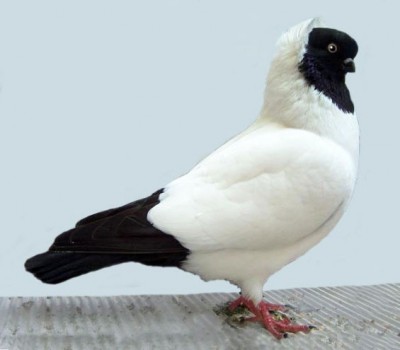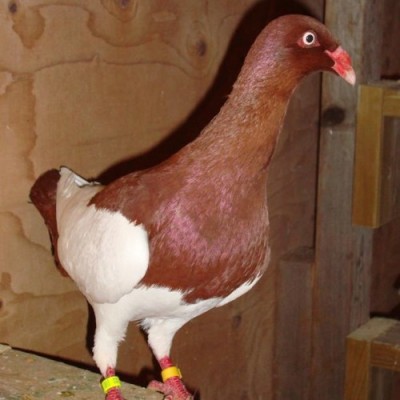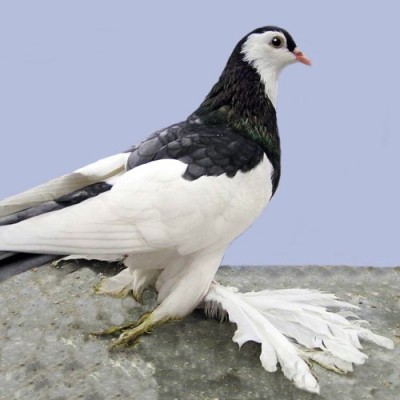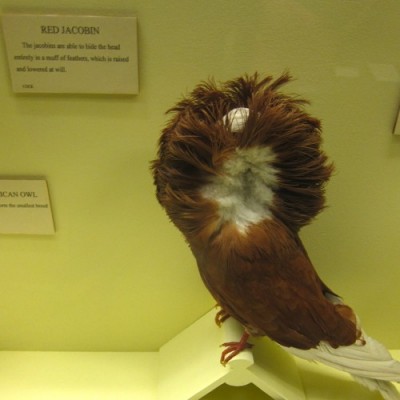Introduction
Pigeons and doves belong to order Columbiformes and family Columbidae. Within family Columbidae, there are five subfamilies consisting of 42 genera and 308 species (Box 1) (Fig 1-Fig 5). Pigeons and doves are found on every continent except Antarctica, and they live in virtually all types of terrestrial habitats (Camfield 2004, Hooimeijer and Dorrestein 1997).
| Box 1. Family Columbidae includes... | |
|---|---|
| Subfamily Columbinae | Doves and pigeons |
| Subfamily Didunculinae | Tooth-billed pigeon or Manumea |
| Subfamily Gourinae | Crowned pigeons |
| Subfamily Otidiphabinae | Pheasant pigeons |
| Subfamily Treroninae | Fruit doves, imperial pigeons |
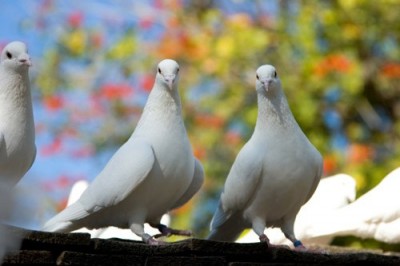
Figure 1. Pigeons and doves, like these racing pigeons shown here, belong to subfamily Columbinae. Image by “kellinahandbasket” via Flickr Creative Commons. Click image to enlarge.
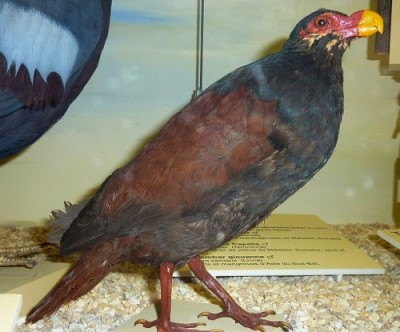
Figure 2. The tooth-billed pigeon (Didunculus strigirostris) of subfamily Didunculinae. Photo by Museum de Genève via Wikimedia Commons. Click image to enlarge.
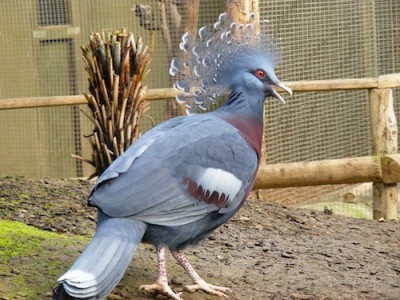
Figure 3. Standing up to 75 cm (30 in) in height, the Victoria crowned pigeon (Goura victoria) of subfamily Gourinae is considered the largest surviving species of pigeon on earth. Photo by Marie Hale via Flickr Creative Commons. Click image to enlarge.
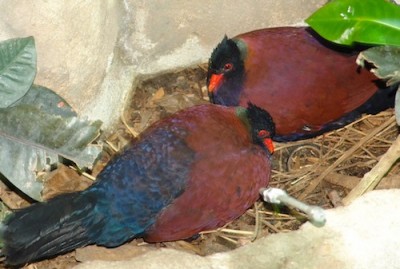
Figure 4. Pheasant pigeons, like the green-naped pheasant pigeon (Otidiphaps nobilis), are large, terrestrial pigeons found primarily in the rainforests of New Guinea and nearby islands. Photo by Drew Avery. Click image to enlarge.
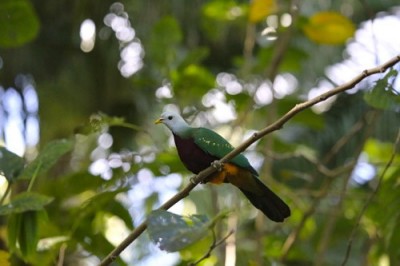
Figure 5. Fruit doves, like the Wompoo fruit dove (Ptilinopus magnificus) shown here, are colorful, fruit-eating doves found in the forests and woodlands of Southeast Asia and Oceania. Photo by cuatrok77 via Flickr Creative Commons. Click image to enlarge.
Columbids tend to be stocky birds with relatively small heads, short beaks, as well as a fleshy cere and a bare ring of skin around the eyes. Columbiforms also tend to have short, squat legs and long keels. Small columbiforms are generally called “doves” while larger birds are often called “pigeons”. Granivorous species tend to be understated beige, brown, or grey colors while frugivores are more brightly colored (Camfield 2004).
TRUE PIGEONS
True pigeons belong to subfamily Columbinae, which consists of 21 genera and 46 species, including the extinct passenger pigeon (Ectopistes migratorius).
Genus Columba: Pigeons
The rock dove (Columba livia) is the common ancestor of all domestic pigeons (Columba livia domestica). Domesticated pigeons that have returned to the wild are also descended from the rock dove and are called city or street pigeons or incorrectly feral pigeons (Hooimeijer and Dorrestein 1997). Street pigeons are found almost exclusively in urban areas near human beings (Pigeon Control Resource Centre 2009).
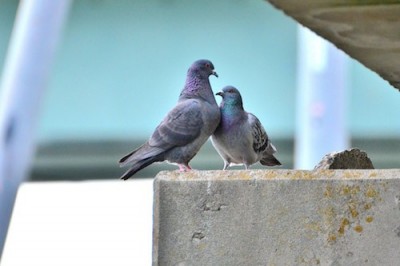
Figure 6. The rock dove (Columba livia) is the common ancestor of all domestic pigeons, including the street pigeons shown here. Photo by Toshihiro Gamo via Flickr Creative Commons. Click image to enlarge.
The common wood pigeon (Columba palumbus) is the most common pigeon found in the United Kingdom (Pigeon Control Resource Centre 2009, BBC News 2005). The common wood pigeon is a large bird. It is primarily grey with white on its neck and wing and pink-tinged feathers on its breast. The common wood pigeon is abundant in southern and western Europe, and it migrates to northern and eastern parts of Europe and western Asia. This species is classified as Least Concern on the International Union for Conservation of Nature (IUCN) Red List.

Figure 7. The common wood pigeon (Columba palumbus) is the most common pigeon in the United Kingdom. Photo by Tim Dutton via Flickr Creative Commons. Click image to enlarge.
Genus Zenaida: Zenaida doves
Mourning doves (Zenaida macroura) are common throughout the United States. Their range extends into southern Canada and down into Panama, and this highly adaptable species is found in a variety of habitats. The mourning dove is the most widespread and abundant game bird in North America, and hunters kill approximately 45 million birds on an annual basis. Fortunately this species is categorized by the IUCN with a Conservation Status of Least Concern.
The mourning dove possesses a long, narrow tail and a small head (Fig 8). This species also exhibits sexual dimorphism. The male tends to be larger and slightly brighter in color than the female. Male mourning doves also possess a bluish crown and a rosy breast.
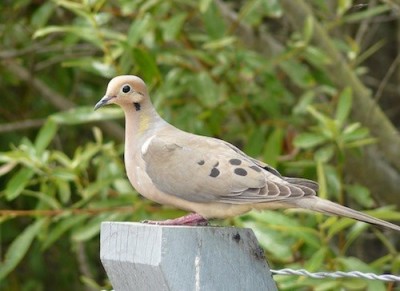
Figure 8. The mourning dove (Zenaida macroura) is a well-managed game bird in North America. Photo by slodocents via Flickr Creative Commons. Click image to enlarge.
Genus Streptopelia: Turtle doves
The ringed turtle dove (Streptopelia risoria), also known Barbary dove, originates from the savannahs and dry woodlands of Africa, however release of captive bred specimens has also led to feral colonies in California, southern Florida, and parts of Illinois USA (Pappas 2002). The ringed turtle dove is a warm creamy buff color with a black semi-collar on the back of its neck. The chin, belly, and tail coverts are white-tinged.

Figure 9. The ringed turtle dove (Streptopelia risoria) is also known as the Barbary dove. Photo by Derek Keats via Flickr Creative Commons. Click image to enlarge.
The Eurasian collared dove (Streptopelia decado) is native to Asia and Europe. The species was introduced to the Bahamas in the 1970s. From there, feral populations made their way to Florida by the 1980s and then rapidly colonized most of North America. The Eurasian collared dove possesses white tail feathers, dark-tipped wings, as well as a black half-collar on the nape.

Figure 10. Feral colonies of the Eurasian collared dove (Streptopelia decado) are found in North America. Photo by Dawn Beattie via Flickr Creative Commons. Click image to enlarge.
Genus Geopelia: Ground doves
The zebra dove (Geopelia striata) and diamond dove (Geopelia cuneata) are native to the open country and scrubland of southeast Asia and Australia. These small doves, with long narrow tails are commonly kept in captivity.
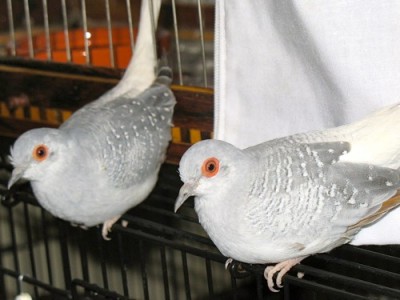
Figure 11. Diamond doves (Geopelia cuneata) are commonly kept in captivity. Photo by Leonardo DaSilva via Flickr Creative Commons. Click image to enlarge.
Genus Gallicolumba: Island ground doves
Island ground doves include the Indo-Pacific ground doves and the bleeding heart doves. These mid-sized columbids are found in the rainforests of the Philippines, Indonesia, and in the Pacific region.
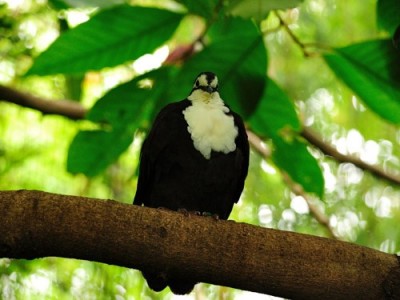
Figure 12. The white-breasted ground dove (Gallicolumba jobiensis) is an island ground dove belonging to genus Gallicolumba. Photo by Kierean Palmer via Flickr Creative Commons. Click image to enlarge.
Genus Caloenas: Nicobar pigeon
The Nicobar pigeon (Caloenas nicobarica) is native to the small islands of Malaysia and Polynesia. This beautiful bird has iridescent green feathers over its dorsum and wing as well as distinctive long feathers that stream down its neck. The Nicobar pigeon is the closest living relative of the dodo (Raphus cucullatus), a large, flightless bird that went extinct in the 1600s (WAZA). The IUCN Red List status of the Nicobar pigeon is Near Threatened.

Figure 13. The Nicobar pigeon (Caloenas nicobarica) is a frugivorous species native to the islands of Malaysia and Polynesia. Photo by cuatrok77 via Flickr Creative Commons. Click image to enlarge.
FANCY BREEDS OF PIGEONS
Pigeon fanciers have bred domestic varieties of the rock pigeon for many different colors, patterns, shapes, sizes, and behaviors. There are over 300 known breeds or varieties of domestic pigeon; birds are often exhibited at pigeon shows, fairs, and livestock exhibits. The body weight of mature birds ranges from 150-180 grams in toy breeds like the African owl to greater than 1400 grams in the American giant runt. Depending on their breed and time of birth, pigeons reach maturity between 5 to 12 months of age. Toy breeds mature faster than late-hatch giant breeds (Harlin 2000).
Utility pigeons
Originally bred for meat production, utility pigeon breeds include the French mondain (Fig 14), the king (Fig 15), and the American giant runt (Fig 16). The giant runt is a very large, heavy bird. The average length of the giant runt is approximately 0.5 m (20 in) with a 1 m (40 in) wingspan. The body weight of this breed has been known to exceed 1.4 kg (3 lb) (Whitby 2013).
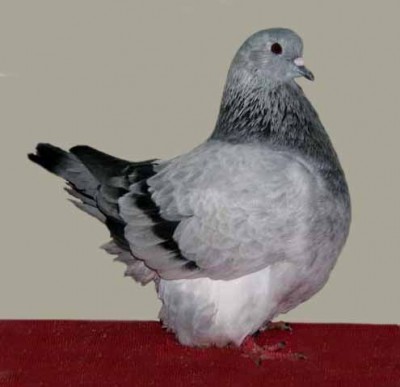
Figure 14. The French mondain is a breed of utility or meat production pigeon. A “blue grizzle” is shown here. Image by Jim Gifford via Wikimedia Commons. Click image to enlarge.
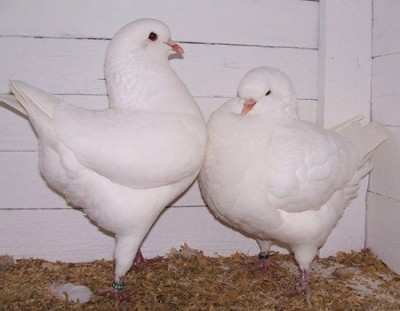
Figure 15. King pigeons are another meat production pigeon. Image by Graham Manning via Wikimedia Commons. Click image to enlarge.
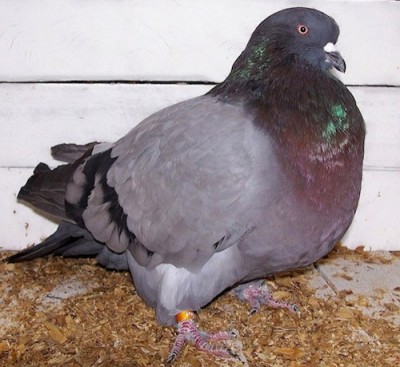
Figure 16. American giant runt. Image by Graham Manning via Wikimedia Commons. Click image to enlarge.
Homing pigeons
Homing pigeons, also known as “homer pigeons” or “messenger or carrier pigeons”, are essentially the marathon athlete of the pigeon world (Rupiper 1998). These birds are used to carry messages and are bred specifically for their ability to find their way home over extremely long distances (Fig 17). Flights as long as 1800 km (1100 miles) have been recorded in competitive races. The average flying speed documented is 80 kilometers per hour (50 mph).

Figure 17. Homing pigeons are bred specifically for their ability to find their way back to their home or loft. Image by Mary Witzig via Wikimedia Commons. Click image to enlarge.
Homing pigeons include breeds designed specifically for show including the English carrier, Dragoon, and German beauty homer (Fig 18). Most racing “homers” weigh between 360 to 480 grams.

Figure 18. Stuffed specimen of a black English carrier pigeon at the Chicago Field Museum. Image by ‘UCFFool’ via Wikimedia Commons. Click image to enlarge.
Tumbler pigeons
Tumbler pigeons, such as high flyers, sustained flyers, flying tipplers, and rollers, are bred for show purposes but can also be used in flying competitions for their acrobatic abilities (Pigeon Control Resource Centre 2009, Hooimeijer and Dorrestein 1997). Some exhibition tumblers, including nuns, English short faced tumblers, and magpie pigeons were originally bred for their acrobatic abilities but crossbreeding has created show birds (Fig 19-Fig 22) (Pigeon Control Resource Centre 2009).
Asian feather and voice pigeons
Specialized breeds, including the fantail, trumpeter and Jacobin, possess extensive feathering as well as a laughing or ‘trumpeting’ voice (Fig 23, Fig 24) (Pigeon Control Resource Centre 2009). Fantail pigeons have rounded bodies and large, flat tails that look like tiny peacocks. These docile birds are a very popular and very old breed.
Color pigeons
There are many different varieties of pigeons bred for their beauty with specific coloring or markings (Fig 25). These varieties may display pastel colors of soft blues, grays, striking black and white, and many different patterns. The swallow, Medena, Danish Suabian (Fig 26), and archangel are just a few examples of color pigeon breeds. Archangels are black pigeons with a coppery sheen. Medenas are stocky, gaily marked pigeons with short tails (Pigeon Control Resource Centre 2009).
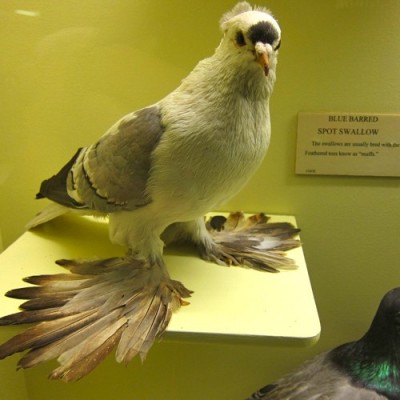
Figure 25. Blue barred spot swallow with feathered toes known as “muffs”. Photo credit: “UCFFool” via Flickr Creative Commons
Pouters and croppers
Pouters and croppers, such as the English pouter, Norwich cropper, and pygmy pouter, possess long, pencil-like legs and the ability to inflate the crop with air so that this region appears like a balloon. Some pouters are crested, others have feathered feet and legs (Fig 27) (Pigeon Control Resource Centre 2009).
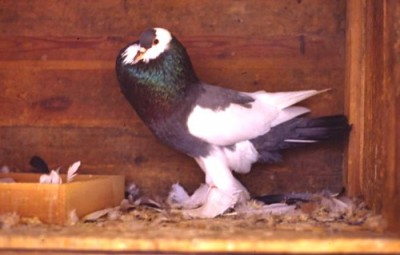
Figure 27. Shown here, a reversewing pouter by Omar Runólfsson via Flickr Creative Commons. Click image to enlarge.
Frills and owls
Breeds like the old German owl, Oriental frill, and Aachen Lacquer shilled owl possess stunted beaks and extraordinary chest feathers (Fig 28-Fig 30).

Figure 28. Shown here, Oriental frills -satinette by Ómar Runólfsson via Flickr Creative Commons. Click image to enlarge.

Figure 29. African owl pigeon by Ómar Runólfsson via Flickr Creative Commons. Click image to enlarge.

Figure 30. Shown here, African owl pigeon by Ómar Runólfsson via Flickr Creative Commons. Click image to enlarge.
Conclusion
Pigeons and doves belong to order Columbiformes and family Columbidae. There are many possible species, breeds, and varieties that may be seen in clinical practice however some of the most common specimens are members of Genus Columba such as the racing pigeon, fancy pigeon, and street pigeon.
References
References
Alderfer J. National Geographic Complete Book of Birds. Washington DC: National Geographic; 2006.
BBC News. Wood pigeon ‘most common UK bird’. BBC News. July 4, 2005. Available at http://news.bbc.co.uk/2/hi/uk_news/4646685.stm. Accessed Dec 21, 2013.
Camfield A. Columbidae. Animal Diversity Web. 2004. Available at http://animaldiversity.ummz.umich.edu/accounts/Columbidae/. Accessed on Dec 6, 2013.
Cornell Lab of Ornithology. Mourning dove. The Cornell Lab of Ornithology website. Available at http://www.allaboutbirds.org/guide/mourning_dove/id. Accessed Dec 6, 2013.
Emiley A, Dewey T. Zenaida macroura. Animal Diversity Web. 2007. Available at http://animaldiversity.ummz.umich.edu/accounts/Zenaida_macroura/. Accessed Dec 21, 2013.
Fancy Pigeon Breed. Breed history. Fancy Pigeon Breeds: South Africa; North of the Vaal Region website. Date unknown. Available at http://fancypigeon.weebly.com/american-giant-runts.html. Accessed April 18, 2016.
Harlin RW. Pigeon therapeutics. Vet Clin North Am Exot Anim Pract 3(1):19-34, 2000.
Hooimeijer J, Dorrestein GM. Pigeons and doves. In: Altman R, Clubb SL, Dorrestein GM, Quesenberry K (eds). Avian Medicine and Surgery. Philadelphia, PA: WB Saunders; 1997. Pp. 886-909.
Pappas J. Streptopelia risoria. Animal Diversity Web. 2002. Available at http://animaldiversity.ummz.umich.edu/accounts/Streptopelia_risoria/. Accessed Dec 21, 2013.
Most popular breed? Most expensive breed? April 12, 2007. Pigeon Talk http://www.pigeons.biz/forums/f27/most-popular-breed-most-expensive-breed-20105.html
The Domestic Pigeon Breed. http://nicksiders.angelfire.com/the-domestic-pigeon-breeds.html. Arkansas State Roller Association website
Pigeon Control Resource Centre. Fancy breeds of pigeons. 2009. Available at http://www.pigeoncontrolresourcecentre.org/html/about-pigeons.html#about8. Accessed April 10, 2016.
Rupiper DJ. Diseases that affect race performance of homing pigeons. Part I: Husbandry, Diagnostic Strategies, and Viral Diseases. J Avian Med Surg 12(2):70-77, 1998.
Whitby S. Giant runt. Whitby Wings Farm & Aviary. Available at http://www.whitbywings.com/giant-runt.html. Accessed April 18, 2016.
World Association of Zoos and Aquariums. Available at http://www.waza.org/en/zoo/pick-a-picture/caloenas-nicobarica. Accessed December 23, 2013.
Pollock C. Order Columbiformes: Species and breeds. LafeberVet Web site. Available at https://lafeber.com/vet/order-columbiformes-species-and-breeds/
